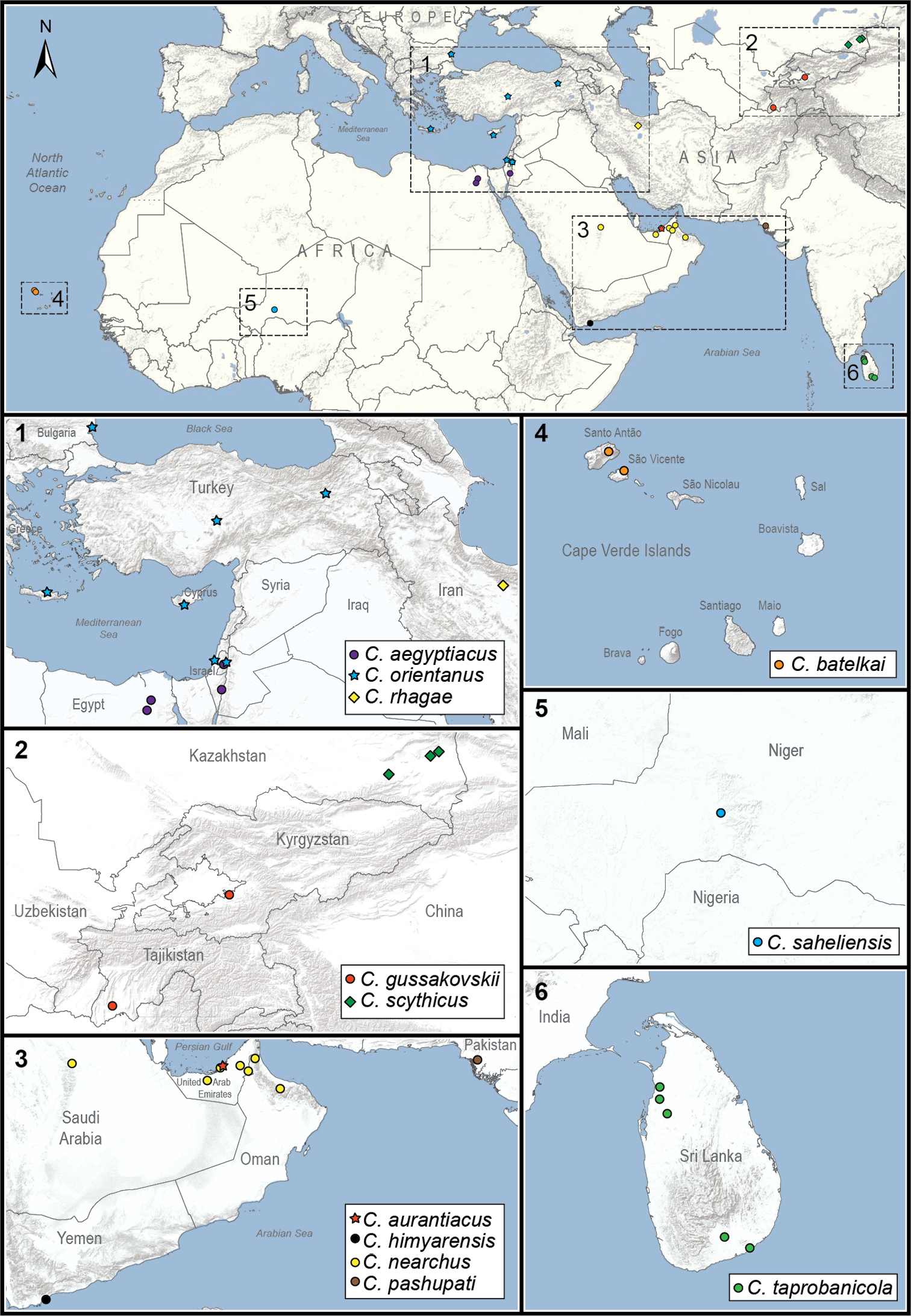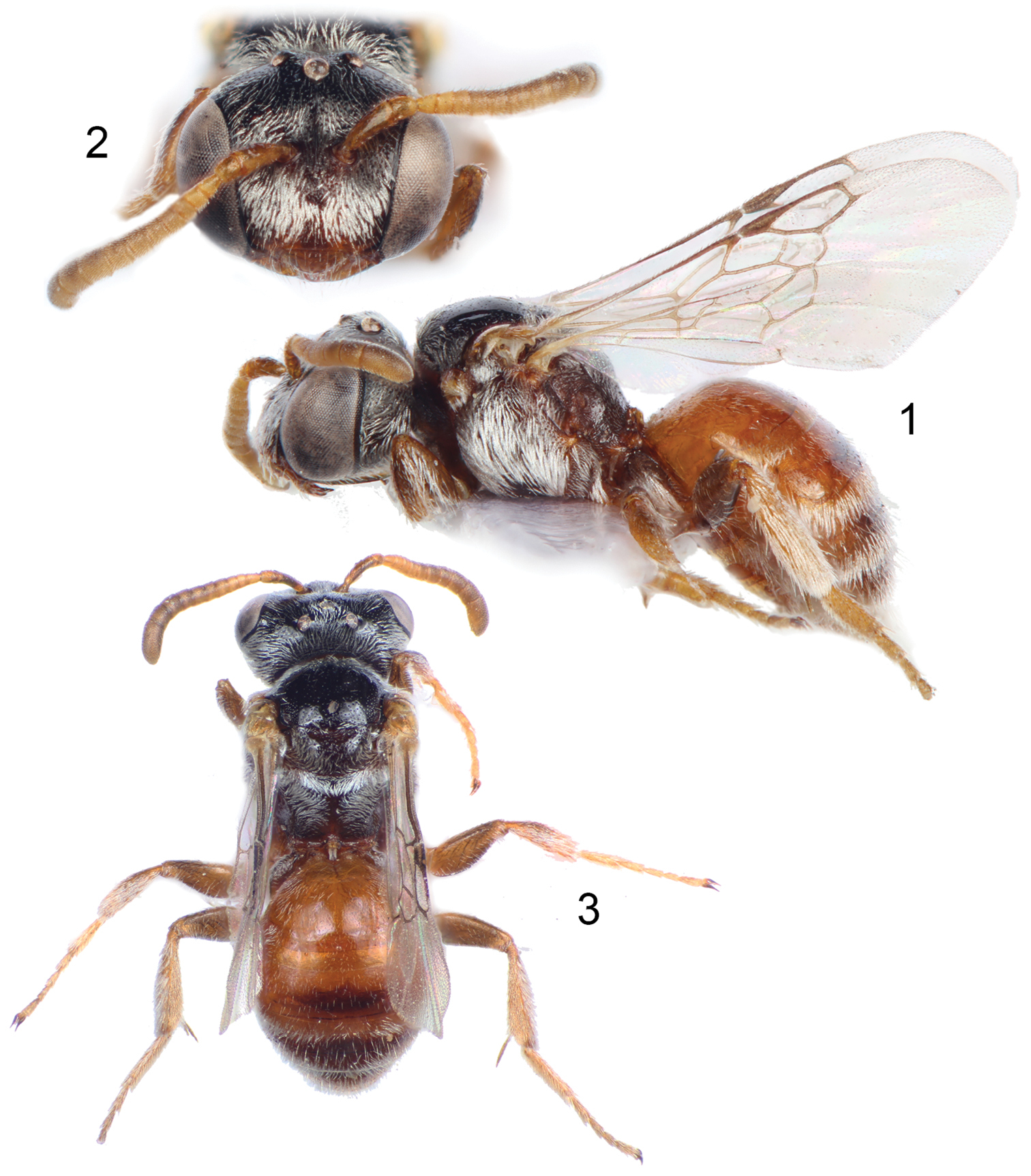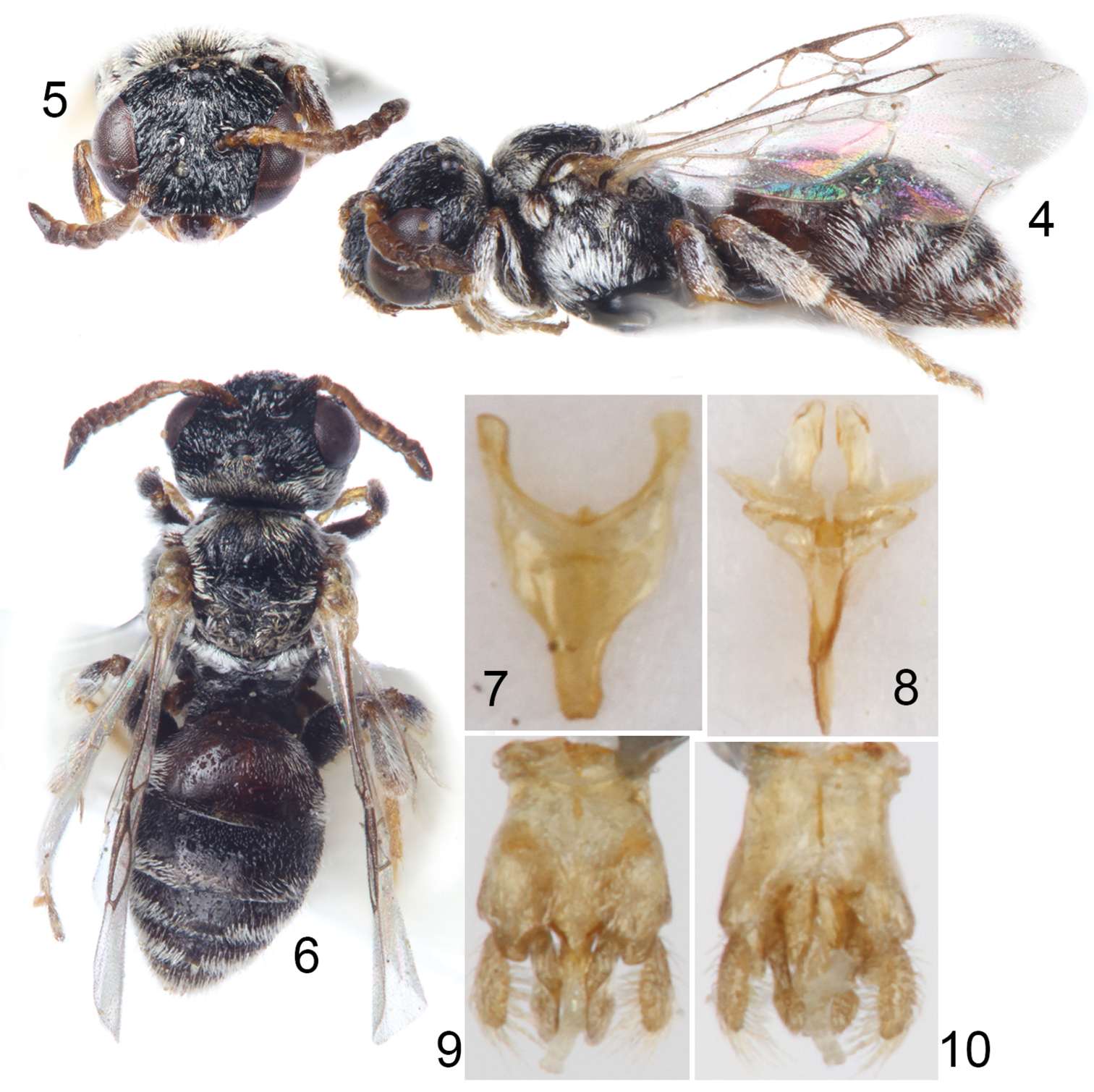Journal of Hymenoptera Research 35: 83–89, doi: 10.3897/JHR.35.5841
First record of Chiasmognathus from the Kingdom of Saudi Arabia (Hymenoptera, Apidae)
Abdulaziz S. Alqarni 1, Mohammed A. Hannan 1, Ismael A. Hinojosa-Díaz 2, Michael S. Engel 3
1 Department of Plant Protection, College of Food and Agriculture Sciences, King Saud University, P.O. Box 2460, Riyadh 11451, Kingdom of Saudi Arabia
2 Department of Environmental Studies, Math & Science Center, 400 Dowman Drive, Emory University, Atlanta, Georgia 30322, USA
3 Division of Entomology, Natural History Museum, and Department of Ecology & Evolutionary Biology, 1501 Crestline Drive – Suite 140, University of Kansas, Lawrence, Kansas 66045, USA
Corresponding author: Abdulaziz S. Alqarni (alqarni@ksu.edu.sa)
Academic editor: W. Pulawski
Citation: Alqarni AS, Hannan MA, Hinojosa-Díaz IA, Engel MS (2013) First record of Chiasmognathus from the Kingdom of Saudi Arabia (Hymenoptera, Apidae). Journal of Hymenoptera Research 35: 83–89. doi: 10.3897/JHR.35.5841
Abstract
The cleptoparasitic bee genus Chiasmognathus Engel (Nomadinae: Ammobatini) is recorded from Saudi Arabia for the first time. Chiasmognathus nearchus Engel was previously known from specimens collected in the United Arab Emirates and Oman. Here we report and figure two individuals captured in central Saudi Arabia.
KeywordsApoidea, Anthophila, cleptoparasitism, cuckoo bees, biodiversity, Ammobatini
Introduction
The cleptoparasitic bee genus Chiasmognathus Engel comprises some of the smallest and most distinctive species of the tribe Ammobatini, and at lengths as low as 2 mm are among the tiniest of all Anthophila (Engel 2006, 2009). Species of Chiasmognathus are found in the east from Central Asia to Sri Lanka, extending from their westward through the Middle East into northern Africa and marginally in southeastern Europe (Engel 2006, 2007, 2008a, 2008b, 2009, 2010; Straka and Engel 2012; Engel and Packer 2013) (Map 1). The largest species, Chiasmognathus batelkai Straka and Engel, is endemic to the Cape Verde Islands and also marks the westernmost occurrence of the genus as it is presently understood (Straka and Engel 2012) (Map 1). Where known, species are cleptoparasites of the equally diminutive bees of the tribe Nomioidini (Engel 2006, 2007, 2009; Rozen 2008; Straka and Engel 2012). Nomioidini are widespread throughout the Old World and it is likely that Chiasmognathus is similarly distributed, with its currently more restrictive range an artifact of sampling. Given that these cleptoparasites are in lower abundance than their hosts, minute in their proportions (even the giants of the genus are scarcely over 4 mm in total length), and frequently sampled only from nesting aggregations of their hosts. Accordingly, records of the genus are scant at present and much remains to be discovered about their systematics, diversity, biogeography, and biology. Rozen (2008) provided information on the immature stages and biology of Chiasmognathus pashupati Engel in Pakistan, and this remains the most extensive source of information regarding the genus.
Map 1.
Distribution of currently described species of Chiasmognathus Engel (Ammobatini); numbered subsets refer to inserts in primary map at top.
During recent sampling efforts across Saudi Arabia two specimens of Chiasmognathus were captured, both from central Saudi Arabia near Riyadh. One female and one male of Chiasmognathus nearchus Engel, previously known from the United Arab Emirates and Oman and known to victimize Nomioides rotundiceps Handlirsch (Engel 2009). Herein we provide details on these new records, adding the genus to the list of supraspecific bee taxa occurring in the Kingdom, and drawing the attention of melittologists in the region to the species in the hopes of learning more about these minute and elusive cleptoparasites.
Material and methods
Material discussed herein was collected as part of general wild bee surveys underway by the authors throughout the Kingdom of Saudi Arabia, ongoing since 2011. Specimens were compared with the original type series of Chiasmognathus nearchus deposited in the Division of Entomology, University of Kansas Natural History Museum (Engel 2009). Photomicrographs were prepared with a Canon 7D digital camera attached to an Infinity K-2 long-distance microscope lens.
Systematics
Genus Chiasmognathus Engel
Material.
1♀ (Figs 1–3), Saudi Arabia: Riyadh, Al Amariah, Majra [Mazra’ah], Al-Gasim [farm], 2.viii.2011 [2 August 2011], I. Naser; 1♂ (Figs 4–6), Saudi Arabia: Riyadh, Honeybee Queen Breeding Station, Ministry of Agriculture, Namar, 9.x.2012 [9 October 2012], M.A. Hannan. The female is deposited in the King Saud University Museum of Arthropods, Plant Protection Department, College of Food and Agriculture Sciences, King Saud University, Riyadh, Kingdom of Saudi Arabia, while the male is deposited in the Division of Entomology, Snow Entomological Collections, University of Kansas Natural History Museum, Lawrence, Kansas, USA.
Figures 1–3.
Female of Chiasmognathus nearchus Engel from Amariah, Saudi Arabia. 1 Lateral habitus 2 Facial view 3 Dorsal habitus.
Comments.
The new material does not differ in any significant manner from the diagnosis and description of the species as provided by Engel (2009). Unfortunately, the sole Saudi male is not preserved in the best condition, with some distortion of the antennae and much of the body matted resulting from the mode of collection and subsequent preparation (Figs 4–6). Nonetheless, it was suitable for dissection and the terminalia are presented here for the first time (Figs 7–10) and for comparison with those structures depicted for other species (e.g., Engel 2006, 2007, 2010; Straka and Engel 2012; Engel and Packer 2013).
Figures 4–10.
Male of Chiasmognathus nearchus Engel from Namar, Riyadh, Saudi Arabia. 4 Lateral habitus 5 Facial view 6 Dorsal habitus 7 Seventh metasomal sternum 8 Eighth metasomal sternum 9 Genital capsule, dorsal view 10 Genital capsule, ventral view.
Presently there are only three species of Chiasmognathus recorded from the Arabian Peninsula: Chiasmognathus aurantiacus Engel from the United Arab Emirates, Chiasmognathus himyarensis Engel from southwestern Yemen, and Chiasmognathus nearchus from Oman, the United Arab Emirates, and now central Saudi Arabia. A key to these species was provided by Engel (2009). The new records presented herein push the distribution of Chiasmognathus nearchus and the genus as a whole westerly into the central desert region of Saudi Arabia. This is not surprising given the broader distribution of the group as well as that of its hosts. Species of Nomioides Schenck and Ceylalictus Strand are both present throughout the peninsula (Pesenko and Pauly 2009) and there is therefore every reason to suspect that with continued intensive sampling additional records will be forthcoming. Moreover, given that there are at least 20 species of Nomioidini present in the region it is possible that new species of Chiasmognathus may be recovered. Given the more varied habitats to the southwest, it is possible that endemic species of the genus may be found in the mountainous regions such as the Asir and Sarawat ranges south from Makkah (Mecca) and Taif, or in the low elevation plain of the Tihamah bordering the Red Sea. Unfortunately, at present none of the Saudi specimens have been collected in a context from which a positive host association can be made. Given that aggregations of Nomioides rotundiceps are in the area, as well as other nomioidine species, it is possible that this is the host of the Saudi populations of Chiasmognathus nearchus just as is the case for those in the United Arab Emirates (Engel 2009).
Acknowledgements
The authors extend their appreciation to the Deanship of Scientific Research at King Saud University for funding the work through the research group project No. RGP-VPP-189. We are grateful to two anonymous reviewers for their constructive commentary.
ReferencesEngel MS (2006) A new genus of minute ammobatine bees (Hymenoptera: Apidae). Acta Entomologica Slovenica 14(2): 113-121.
Engel MS (2008a) New species and new records of ammobatine bees from Pakistan, Kyrgyzstan, and Sri Lanka (Hymenoptera: Apidae). Acta Entomologica Slovenica 16(1): 19-36.
Engel MS (2008b) A new species of
Chiasmognathus from Iran, with a note on
Chiasmognathus aegyptiacus in Israel (Hymenoptera: Apidae). Beiträge zur Entomologie 58(2): 223-226.
Engel MS (2009) The bee genus
Chiasmognathus in the Arabian Peninsula (Hymenoptera: Apidae). Fauna of Arabia 24: 237-247.
Engel MS (2010) A new species of the bee genus
Chiasmognathus from southwestern Niger (Hymenoptera: Apidae). Acta Entomologica Musei Nationalis Pragae 50(1): 273-278.
Engel MS, Packer L (2013) A new species of
Chiasmognathus from Kazakhstan (Hymenoptera: Apidae). Journal of Melittology 10: 1-7.
Pesenko YA, Pauly A (2009) A contribution to the fauna of the nomioidine bees of the Arabian Peninsula (Hymenoptera: Halictidae). Fauna of Arabia 24: 217-236.
Rozen JG Jr (2008) Biology and immature stages of
Nomioides patruelis (Halictidae: Halictinae: Nomioidini) and of its cleptoparasite
Chiasmognathus pashupati (Apidae: Nomadinae: Ammobatini), with a preliminary phylogeny of the Halictidae based on mature larvae (Apoidea). American Museum Novitates 3604: 1-23. doi:
10.1206/0003-0082(2008)3604[1:BAISOT]2.0.CO;2Straka J, Engel MS (2012) The apid cuckoo bees of the Cape Verde Islands (Hymenoptera, Apidae). ZooKeys 218: 77-109. doi:
10.3897/zookeys.218.3683









